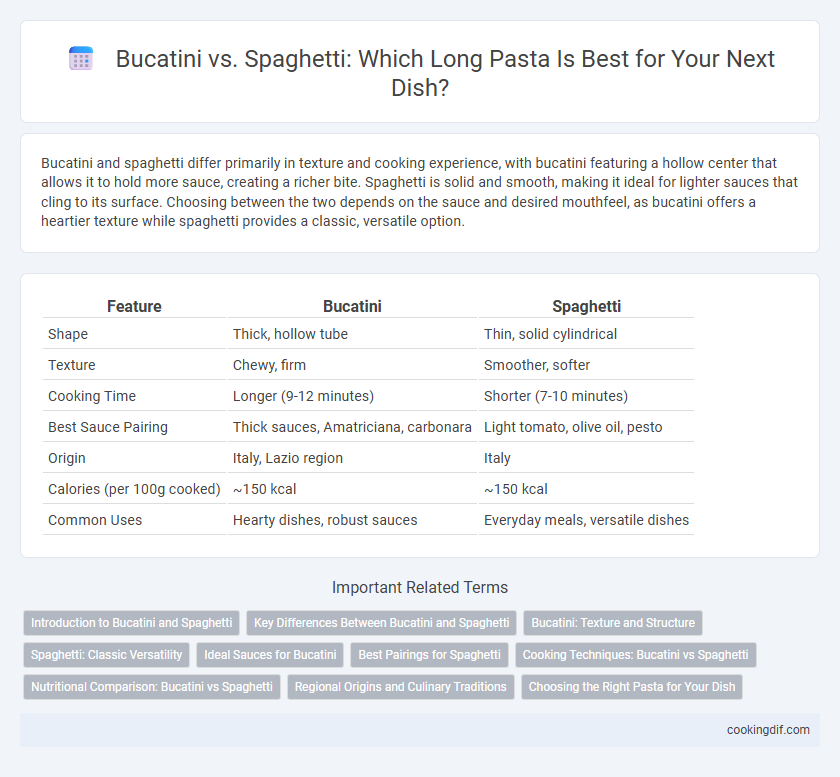Bucatini and spaghetti differ primarily in texture and cooking experience, with bucatini featuring a hollow center that allows it to hold more sauce, creating a richer bite. Spaghetti is solid and smooth, making it ideal for lighter sauces that cling to its surface. Choosing between the two depends on the sauce and desired mouthfeel, as bucatini offers a heartier texture while spaghetti provides a classic, versatile option.
Table of Comparison
| Feature | Bucatini | Spaghetti |
|---|---|---|
| Shape | Thick, hollow tube | Thin, solid cylindrical |
| Texture | Chewy, firm | Smoother, softer |
| Cooking Time | Longer (9-12 minutes) | Shorter (7-10 minutes) |
| Best Sauce Pairing | Thick sauces, Amatriciana, carbonara | Light tomato, olive oil, pesto |
| Origin | Italy, Lazio region | Italy |
| Calories (per 100g cooked) | ~150 kcal | ~150 kcal |
| Common Uses | Hearty dishes, robust sauces | Everyday meals, versatile dishes |
Introduction to Bucatini and Spaghetti
Bucatini and spaghetti are two popular types of long pasta, each offering unique textures and culinary experiences. Bucatini is thicker and hollow, providing a satisfying chew and the ability to hold rich sauces inside its tube-like structure. Spaghetti is thinner and solid, making it versatile for a wide range of dishes, from classic marinara to carbonara.
Key Differences Between Bucatini and Spaghetti
Bucatini features a hollow center that allows sauces to penetrate the pasta, creating a richer flavor experience compared to solid spaghetti. Spaghetti has a thinner, solid structure ideal for lighter sauces, while bucatini's thicker, tubular shape pairs well with thicker, hearty sauces. The distinct texture and sauce retention capabilities make bucatini a preferred choice for dishes like amatriciana, whereas spaghetti is more versatile for simple olive oil or tomato-based sauces.
Bucatini: Texture and Structure
Bucatini features a thicker, hollow tube structure that provides a unique chewy texture and better sauce retention compared to traditional spaghetti. The pasta's hollow center allows sauces to penetrate inside, enhancing flavor absorption and delivering a more satisfying bite. This distinctive texture and structure make Bucatini ideal for rich, hearty sauces such as carbonara and amatriciana.
Spaghetti: Classic Versatility
Spaghetti stands out for its classic versatility, making it ideal for pairing with a wide range of sauces from simple marinara to rich Bolognese. Its thin, round strands cook quickly and evenly, providing a perfect texture that complements both light olive oil-based dressings and hearty meat sauces. Unlike bucatini, which has a hollow center, spaghetti's solid form allows it to absorb flavors on the surface, enhancing the overall taste experience.
Ideal Sauces for Bucatini
Bucatini, a hollow long pasta, pairs best with thick, rich sauces that can fill its central hole, such as amatriciana, carbonara, and robust tomato-based ragu. Its unique tubular shape holds sauces better than spaghetti, which is solid, making Bucatini ideal for chunky or creamy sauces. Sauces with small ingredients like pancetta or peas cling inside Bucatini, enhancing every bite with concentrated flavors.
Best Pairings for Spaghetti
Spaghetti pairs exceptionally well with light tomato sauces, garlic and olive oil, or seafood-based sauces like clam sauce, enhancing its thin, smooth texture. Its slender shape allows it to absorb flavors evenly, making it ideal for classic dishes such as spaghetti aglio e olio or spaghetti alle vongole. While bucatini offers a hollow center for thicker sauces, spaghetti remains the top choice for delicate, well-balanced pairings.
Cooking Techniques: Bucatini vs Spaghetti
Bucatini requires slightly longer cooking times than spaghetti due to its thicker, hollow structure, which allows sauce to seep inside for enhanced flavor absorption. Spaghetti, being thinner, cooks faster and absorbs sauces primarily on the surface, making it ideal for lighter, oil-based dressings. Properly timing the cooking ensures bucatini achieves a chewy texture without becoming mushy, while spaghetti maintains its signature al dente bite.
Nutritional Comparison: Bucatini vs Spaghetti
Bucatini and spaghetti offer similar calorie counts per serving, with bucatini slightly higher due to its thicker, hollow structure which may retain more sauce and nutrients. Both pastas provide comparable amounts of carbohydrates and protein, but bucatini tends to have a marginally higher fiber content, supporting better digestion. When choosing between the two, consider that bucatini's hollow center allows for a richer sauce absorption, potentially enhancing the nutrient profile of the meal.
Regional Origins and Culinary Traditions
Bucatini originates from Lazio, particularly Rome, where its hollow center captures rich sauces typical of Roman cuisine, such as amatriciana and carbonara. Spaghetti, a staple in Naples and southern Italy, pairs traditionally with simpler tomato-based sauces like marinara or aglio e olio, reflecting the region's emphasis on fresh, bold flavors. Both pastas represent distinct regional culinary traditions that influence their preparation and sauce compatibility.
Choosing the Right Pasta for Your Dish
Bucatini offers a hollow center that holds sauces better, making it ideal for rich, hearty sauces like amatriciana or carbonara. Spaghetti's thin, solid strands work well with lighter, smoother sauces such as marinara or aglio e olio, ensuring a delicate balance without overwhelming the dish. Selecting bucatini or spaghetti depends on the sauce's texture and intensity to create the perfect harmony between pasta and flavor.
Bucatini vs spaghetti for long pasta Infographic

 cookingdif.com
cookingdif.com